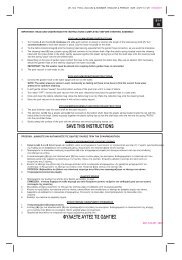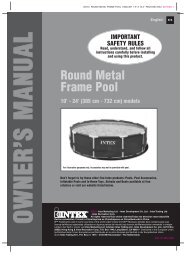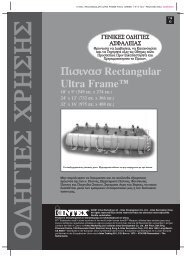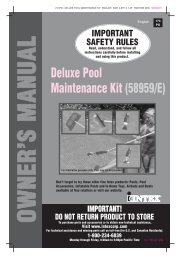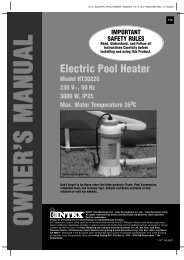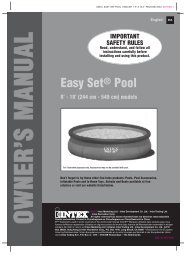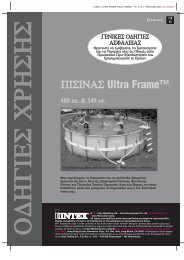save these instructions - INTEX ++
save these instructions - INTEX ++
save these instructions - INTEX ++
Create successful ePaper yourself
Turn your PDF publications into a flip-book with our unique Google optimized e-Paper software.
(94IO) "ISO" KAYAK (TYPE IIIB) ENGLISH 7.5” X 10.3” 03/28/2012<br />
Rules to Observe During Navigation<br />
• Be responsible, do not neglect the safety rules, this could jeopardize your life and the lives of<br />
others.<br />
• Always keep control of your boat.<br />
• Respect local regulations and practices.<br />
• Near the shore, navigate in the designated boating area.<br />
• Remember that weather conditions can rapidly deteriorate. Always be sure that you can reach a<br />
shelter rapidly.<br />
• Everyone on board must always wear a personal flotation device (PFD).<br />
• Do not drink alcohol or take drugs before or while operating your boat. Maintain passenger<br />
sobriety.<br />
• Do not exceed the authorized number of persons or weight.<br />
• Make sure your passengers remain seated at all times. At planning speeds, in rough water or<br />
during sharp turns, all passengers should position themselves in seats or on the floor.<br />
• No bow riding. Bow riding is illegal in most areas and is extremely dangerous. In case of falling,<br />
the man overboard is in the way of the propeller.<br />
• Be especially careful when docking. Arms and legs may be injured if they are outside the boat.<br />
• Keep clear of swimmers and divers. Always avoid areas where divers/swimmers are in the water.<br />
• Keep a sharp lookout especially when operating near beaches and launch sites. The Alpha flag<br />
indicates proximity of divers. You MUST maintain a safe distance as required by your local<br />
boating laws, which may range from 50 meters (164 feet) to 91 meters (300 feet).<br />
• Avoid sharp turns at high speeds. You could get ejected from the boat.<br />
• Do not make changes in direction without advising passengers.<br />
• Avoid all contact between the buoyancy tubes and sharp objects or aggressive liquids (such as<br />
acid).<br />
• Do not smoke on board.<br />
Care and Maintenance<br />
The kayak is made of the highest quality materials and complies with ISO 6185 standards. Altering<br />
the construction of the kayak will endanger your own safety, safety of the occupants and void the<br />
limited warranty!<br />
There is very little that you have to do to keep your kayak in good condition for many years. Do not<br />
store your kayak inflated. If you store it in a closet, basement or garage, we suggest you pick a cool,<br />
dry place, making sure the kayak is clean and dry before you store it - or mold can accumulate.<br />
Use as few cleaning agents as possible, do not discharge waste agents into water, and clean your<br />
kayak preferably on land.<br />
Clean your kayak after a trip to prevent damage from sand, salt water or sun exposure.<br />
Most dirt can be removed with a garden hose, a sponge and mild soap. Make sure the kayak is<br />
completely dry before storing. Store the product and accessories in a dry, temperature controlled,<br />
between 32 degrees Fahrenheit (0 degrees Celsius) and 104 degrees Fahrenheit (40 degrees<br />
Celsius) storage location.<br />
94A<br />
SAVE THESE INSTRUCTIONS<br />
Page 8



